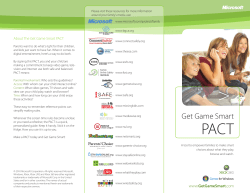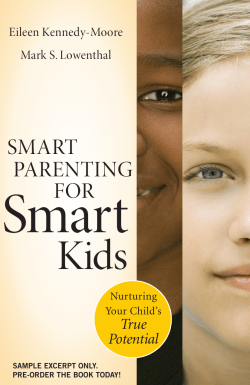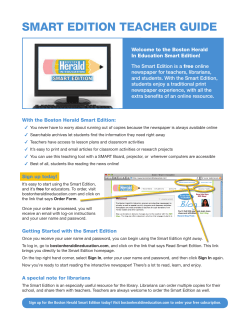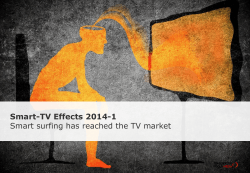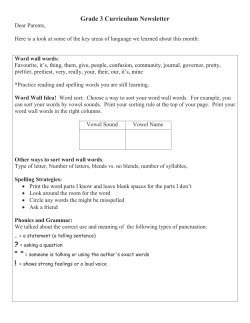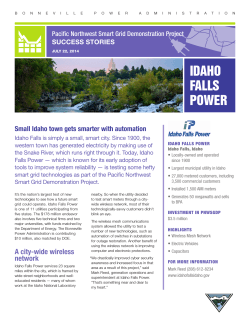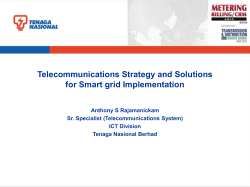
Grants and Fundraising magazine Funding
April 2012 magazine Grants and Fundraising Looking for Love Funding in All the Wrong Places? By Eric Jansson Learn how and where to find funding for SMART products Strategically Achieving Funding Success By Stacy Kindopp Finding Funding for Classroom Technology By Glenn Cermak F RO M TH E E DITO R Grants and Fundraising Funding for classroom technology – finding it, working to get it and deciding how to effectively spend it – is an ongoing quest for many educators. Finding funding takes both creativity and persistence. At the classroom level, hidden sources of funding can be available right in your community. Sometimes, it’s as simple as asking community service organizations, local companies or individuals. You’d be surprised how often they want to help. Whether you want to learn how other teachers are successfully acquiring funding or if you’re just looking for the inspiration to get started, this issue is loaded with tips, tools, resources and best practices from teachers who‘ve gone hunting for funds – and found them. Once you’ve read this issue, we invite you to take our reader survey and tell us what you think of EDCompass magazine. Tell us what works, what you’d like to see changed and how we can ensure you’re getting a monthly magazine that meets your needs. After you complete the survey, you’ll also have a chance to win a SMART Document Camera™. Read pages 20 and 21 to find the survey and other great opportunities to win SMART products for your school. I hope you enjoy our grants and fundraising issue, and you discover a few valuable tips to start you on your own quest to fill your classroom with SMART products. Shari-Lynn Sare, EDITORIAL Shari-Lynn Sare, Managing Editor Chrissie Chambers, Editor CONTRIBUTORS Shari-Lynn Sare Stacy Kindopp Wendy McMahon Glenn Cermak Eric Jansson ART Michelle Rampaul, Designer, Digital Production Photography on page 26 by Jon Pernul As always, you can e-mail any questions or feedback about EDCompass magazine or the blog to EDCompassfeedback@smarttech.com. Subscribe Receive monthly issues of EDCompass magazine right to your inbox. Sign up now for your complimentary subscription. MANAGING EDITOR © 2012 SMART Technologies. All rights reserved. EDCompass, SMART Document Camera, SMART Response, SMART Board, SMART Exchange, SMART Notebook, SMART Table, SMART Slate, SMART Classroom Suite, SMART Sync, smarttech, the SMART logo, all product logos and all SMART taglines are trademarks or registered trademarks of SMART Technologies in the U.S. and/or other countries. All thirdparty product and company names are for identification purposes only and may be trademarks of their respective owners. 2 | April 2012 CO NT E NT S 04 NOTES FROM THE FIELD With Glenn Cermak Finding Funding for Classroom Technology 06 GRANTS AND FUNDRAISING With Eric Jansson Looking for Love Funding in All the Wrong Places? 12 CLASSROOM CONTENT SMART Notebook Tips Hide and Reveal 20 NEWS What’s Happening This Month Find out about SMART’s latest opportunities and happenings 22 SMART SHOWCASE SCHOOL PROFILE Buying SMART Products on a Budget 14 FEATURE ARTICLE Strategically Achieving Funding Success 24 PRODUCT SPOTLIGHT Bring Your Favorite Lesson Tools Together 26 ASK ALLISON SMART Notebook 11 Collaborative Learning Software April 2012 | 3 N OT ES F RO M TH E FI E LD Finding Funding for Classroom Technology Glenn Cermak Technology Integration Facilitator Central Dauphin School District Harrisburg, Pennsylvania " The focus should always be on how SMART products benefit students – and no one can explain that better than the students ” themselves. 4 | April 2012 Schools everywhere are facing funding problems. Unfortunately, it often means less money for classroom technology. And for those of us who have used SMART products with our students, we know that less funding is the opposite of what needs to happen if we want to provide the best education for our students. Over the past four years, I have worked with schools and districts to purchase SMART products through support from the community. The biggest factor for successful fundraising is involvement – from students and the community. The more you include students the better. Involve student organizations such as student council or the National Honor Society to help plan and execute fundraisers. If you are going to your school board or to local businesses, bring students with you and let them do most of the talking. People don’t want to know how much time the SMART Response™ interactive response system will save me on grading – they want to know why students like it and how it helps them learn. I’ve also found that community members know very little about SMART products, making them reluctant to offer financial support. The most effective solution is to actually use SMART products where people can see them. Use a SMART Board® interactive whiteboard to track teams through a bracket at a charity basketball game or have your parent-teacher association or school board conduct voting using SMART Response. The more they see SMART products being used, the more likely they will be to support your cause. For examples of fundraisers and for other tips, you can view my presentation from ISTE 2011 on the SMART Exchange™ website. VOIC E BOX have your say.... Last Month’s Poll Results We asked what your biggest challenges are when implementing technology into a Title I classroom. Your Vote What is the most important source of funding for your school? Vote now 20% Teachers are not involved in decisions about classroom technology for the school 15% Hesitant to use or lack of interest in classroom technology 15% Not enough time for professional development 15% School infrastructure 15% Professional development isn’t provided by the district 20% Other Up Next Read the next issue of EDCompass magazine, where we highlight SMART’s training and professional development opportunities to help you make the most of your SMART products. April 2012 | 5 G R A NT S A N D F U N D R AISING Looking for Love Funding in All the Wrong Places? By Eric Jansson, Senior Education Policy Manager, SMART Technologies It’s no secret that funding for education is tight these days. Although signs of relief are on the horizon with recovering state economies and budgets, educators still need to be entrepreneurial when searching for funding. For that reason, we’ve updated the grants and fundraising pages on our website and added a focus on alternatives to traditional grant opportunities. State and federal grant programs and charitable foundation programs remain important sources of funding, but many districts have found success working with local businesses or corporations. Consider the example of SkyLine Membership Corporation, a provider of telecommunications services and support for North Carolina schools. The front page of its January 2012 newsletter, Connections, describes its longstanding work with communities to improve education. 6 | April 2012 According to the article, the SkyLine Technology Education Grant Program has awarded grants totaling US$55,000 to enhance education by placing SMART Board interactive whiteboards in classrooms. Examples of similar private support abound and it’s not surprising – companies benefit from strong schools and communities, too. The updated grants and fundraising pages on SMART’s website are designed to help teachers and schools not only succeed in obtaining traditional grants and funding but also plan how to approach local businesses. Not all grants need to be solicited through an open request process – if you have a great idea, there may be local companies willing to fund it. Do you have a successful or unique grant or fundraising story to share? If so, we’d love to hear it. Please share your success stories and suggestions on the EDCompass blog. G R A NT S A N D F U N D R AI SING Finding Funding Our website offers resources that can help you secure alternative funding for SMART products. We’ve categorized information into grants and fundraising to help streamline your search. Following is just a glimpse of what you’ll find. Grants Fundraising Gather essential tips for finding the right grant opportunities and writing the applications. Our website provides information about the different organizations that offer grants, along with success stories of schools that have turned their plans into reality. Because your time is limited and it’s difficult to know where to find supporting information for your application, we also provide research and case studies that prove the massive effect classroom technology has on improving learning outcomes. Learn more about grants. Find tips and tactics to help you plan a fundraising campaign. You can also learn about the Sponsor-A-Classroom program, which shows you how to partner with community donors who can fund your purchase of SMART products. We’ve created a collection of guidelines and customizable templates you can use to support your fundraising efforts. Learn more about fundraising. On SMART Exchange On the SMART Exchange website, you’ll find helpful tips, ideas and inspiration for getting your fundraisers and grant applications started. Following are two SMART Notebook™ files from teachers who share their best practices for successful initiatives. Meadows Parent Party – An Evening in Paris Educators at Meadowview Elementary School in Manhattan Beach, California, share what they did to raise funds for SMART products. You can gather lots of ideas for your fundraiser and a vision for the range of donors you can approach. Community Support and Funding for SMART Product Purchases Glenn Cermak, who contributed this month’s Notes from the Field, provides tips for getting the community involved in your fundraising efforts. He also suggests different events you can hold to raise the money you’ll need to fill your classroom and school with SMART products. April 2012 | 7 C L A SS ROO M CO NT E NT ON THE SMART SMART Notebook Lessons With more than 15,000 ready-made or customizable SMART Notebook lessons on the SMART Exchange website, you can be sure your curriculum stays fresh and exciting. You can find a growing database of lesson content for all grades and subjects – many of which are standards correlated – created by classroom teachers or by SMART’s team of curriculum resource developers. You can also search for Common Core State Standards-correlated lessons for math and English language arts by clicking the Standards-Correlated Lessons button in the top navigation bar on the home page of SMART Exchange. Because April is Earth Month and in recognition of Earth Day on April 22, here are a few fitting lessons you can try with your students. Celebrate Earth Day K–2 students can learn about Earth Day and the environment, and discover ways they can contribute to cleaning up the Earth. 8 | April 2012 Earth and Beyond In this lesson from Skoool, students in grades 7–9 can learn about the Earth, moon and sun, and how the moon changes shape as it relates to the sun and Earth. The Ozone Shield and Global Warming Students in grades 9–12 can learn about the ozone, its importance to the universe and how it can be preserved. Students will also learn about chlorofluorocarbons, the stratospheric ozone, climate and environmental science. C L A SS RO O M CO NT E NT Exchange SMART Response Question Sets WEBSITE SMART Exchange also offers a growing number of SMART Response question sets, most of which are correlated to state and provincial curriculum standards. The website contains hundreds of activities for all subjects and grade levels. Try one of the following SMART Response question sets in your next class. Seasons, Days and Months Students in grades 4–6 can learn about the seasons, days and months and how seasons differ around the world. Whales of the World This activity combines a lesson and question set for students in grades 4–8 who are learning about whales, the largest mammals on Earth. The activity also includes whale song audio files and a video of a humpback whale feeding. The Solar System Tenth-grade students can test their knowledge of the planets in our solar system. April 2012 | 9 C L A SS ROO M CO NT E NT SMART Table Activities Developed specifically for early education classrooms, check out the growing number of activity packs for the SMART Table® interactive learning center on the SMART Exchange website. You can search by topic, subject or grade level to access hundreds of activities for your SMART Table. You can use SMART Table activities with small groups to complement whole-class and individual learning experiences. Most activities correspond to a SMART Notebook lesson and SMART Response question set. Following are a few SMART Table activities you can try in your next class. The Weather and My Senses Students can explore how they use their senses to observe the weather. 10 | April 2012 Today and Tomorrow Students can learn how to distinguish the past, present and future by describing events in terms of yesterday, today and tomorrow. Time and Money This activity incorporates the basics of time and money with several activities that correspond with the time on an analog clock. C L A SS RO O M CO NT E NT SMART-Accredited Resources The SMART Software and Content Accreditation Program encourages third-party publishers to develop software and content that integrates with SMART products, ensuring you have access to digital content that’s compatible with all the SMART products in your classroom. When software or content is accredited by SMART, it carries our accreditation logo. And before we accredit a title, we ensure that the product will be easy to use and will enable you to enhance learning in your classroom. You can find SMART-accredited publisher content on SMART Exchange under the tab Accredited Titles. We’ve highlighted a few of them here. Phonics 3 – Phonics to Spelling This activity by EDpaX International helps students in grades 1–3 learn to identify, read and spell words. Global Warming – Causes This activity by Classroom Complete Press provides students in grades 3–8 with insight into the science of the atmosphere and the effects of human actions on the Earth. Flower Anatomy This activity by Teq is a 3D model of a flower that you can move to show and discuss its different angles and parts. April 2012 | 11 C L A SS ROO M CO NT E NT SMART Notebook Tips Hide and Reveal You can add interactivity to a lesson by using a reveal activity, such as hiding the answer to a question behind an object on your SMART Notebook software page or by using the erase or Screen Shade features. Here’s how: 1 Click the Text button on the toolbar and type your question and answer in the working area of a SMART Notebook software page. Click the Shapes button on the toolbar, select a shape and then drag your mouse pointer to draw that shape over the answer. 2 3 Click the Fill button on the toolbar for the Fill Effects panel to appear and select the color and type of fill you’d like to use in your shape – solid, gradient, pattern or image. Then click inside your shape to fill it with your selections. 12 | April 2012 4 Click the Select button on the toolbar and double click your shape. A text box will appear where you can add instructions. You can also change the font style, color and alignment by selecting your options from the toolbar. 5 Right-click the object that is covering the answer and select Order from the popup menu. Select Bring to Front to ensure your students don’t see the answer before you want to reveal it. 6 During the lesson, move the shape to reveal the answer. C L A SS RO O M CO NT E NT Use the eraser to reveal the answer 1 Repeat step 1 from hide and reveal. Click the Pens button on the toolbar to select a pen from the toolbar that appears. 2 Click the Properties tab on the side of your SMART Notebook software page and select the Line Style, Thickness of the line you’d like to use. Then, choose a Color that matches the background of your page. 3 4 Use your mouse pointer to draw over the answer and cover it with digital ink that is the same color as your page. During your lesson, select the Eraser button from the toolbar or pick up the eraser from the Pen Tray to erase the digital ink and reveal the answer. Hide information beneath a Screen Shade 1 Type the information you want hidden in the working area of your SMART Notebook software page and click the Show/Hide Screen Shade button on the toolbar. A gray shade will cover your page. 2 Resize your shade by using the small circles that appear near the edges of the shade. You can move the shade up or down and left or right to reveal the page in stages. Download SMART Notebook 11 software. April 2012 | 13 Strategically Achieving Funding Success By Stacy Kindopp F E AT U R E A R TIC LE Creating equal learning opportunities Shannon Donovan is known for extending her teaching beyond the four walls of her classroom by involving her science students at Scituate High School in Rhode Island in a variety of applied learning projects. Students explore environmental science concepts by restoring the walking trail behind the school, share their physical science knowledge by showcasing energy efficiency and renewable energy concepts to the community and discover more about plant propagation by growing plants in the greenhouse for a community plant sale. So when Donovan was named Rhode Island Teacher of the Year in 2011 and received a Teaching Excellence Award (TEA) Technology Classroom from SMART, she could further expand learning in her classroom through interactive lessons and easily gauge student understanding with formative assessments. The TEA Technology Classroom included a SMART Board 685ix interactive whiteboard system, a SMART Response PE interactive response system, SMART Notebook collaborative learning software, SMART Notebook Math Tools, a SMART Slate™ wireless slate and a SMART Document Camera. April 2012 | 15 F E AT U R E A R TIC LE “I loved it and the students loved it! Other people in my department were stopping by to explore the features of SMART Notebook software. They saw the great response from my students,” says Donovan. “I find that using SMART Response for interactive assessments is highly effective. Now when my students are learning new concepts, I can quickly get a sense of where the issues are, and the students are more engaged,” she says. The visual, interactive features of SMART Notebook software help Donovan better clarify concepts, such as dimensional analysis. “Having the ability to change pen colors frequently and move items around really helps my students visualize the dimensional analysis,” says Donovan. The science department at Scituate High School has six classrooms, and with the addition of the SMART Board interactive whiteboard that Donovan received, “I knew that I had to be able to tell a compelling story as I tried to get my objectives and reasoning across to the grant reviewers. I tried to be concise, clear and powerful with my words.” – Shannon Donovan, Science Teacher, Scituate High School, Scituate, Rhode Island two of those classrooms were outfitted with SMART Board interactive whiteboards. Donovan then began looking for opportunities to bring SMART products to the other four science classrooms. She’d had previous success with grant applications, so she started looking for funders that were aligned with her goals. Wanting to ensure that every science student could experience the same collaboration and interactivity that she offered in her classroom, Donovan was determined to close the equity gap that now existed in the science department. She saw a call for proposals from Champlin Foundations and shared her story in a single-page grant request. “I knew that I had to be able to tell a compelling story as I tried to get my objectives and reasoning across to the grant reviewers. I tried to be concise, clear and powerful with my words,” explained Donovan. In her application, Donovan said how formative assessments using SMART Response provide the instant responses that enhance her teaching and help her students direct their studies more effectively. She talked about how all Scituate science 16 | April 2012 F E AT U R E A R TIC LE students should have this opportunity, no matter which science classroom they were in. Her grant application was successful and the science department was awarded a US$59,000 grant. With the funds, the department was able to purchase SMART products for every science classroom and acquire laptops with geographic information systems software. “We are all excited now! We’ve only had the new products for a few weeks, but the kids are ready to go. They want to jump in!” says Donovan. Although Donovan has had success with grant applications, she isn’t ready to apply for every grant opportunity she sees. “Grant writing takes a fair amount of time and effort. Time is better spent carefully selecting which grant opportunity is right for your needs, rather than doing a broad approach,” she explains. Donovan encourages educators to carefully research funders before completing a grant request. “You have to read between the lines and figure out what they’re looking for. Visit their website to see if they list past projects that they’ve funded. If so, read them and see if your project matches up,” she suggests. “To find grant opportunities, my advice is network, network, network! I’ve found opportunities through listings provided by the National Science Teachers Association, communications from the U.S. Department of Education and other professional organizations and groups related to my fields of study. Have your ear to the tracks and in as many different realms as you can,” says Donovan. Making the most of your budget In addition to seeking out grants and looking for fundraising opportunities, many schools and districts are now streamlining processes and systems to help them do more within their existing budgets. At recent statewide school administrator association meetings in Mississippi and Michigan, SMART has sponsored sessions to help administrators find ways to make the most of their resources. “We know it’s a difficult economic time, and we want to do our part to help move education forward,” says Rae Mugnolo, Education Policy Manager at SMART. “We want to be active in helping schools and districts discover new strategies for getting the most from every budget dollar.” Eric Peterson, President and CEO of Peterson Public Sector Consulting, has presented at the SMART-sponsored sessions. He regularly works with schools and districts to help them generate funds through cost-avoidance strategies and resource redeployment. April 2012 | 17 F E AT U R E A R TIC LE Peterson is also on the management team of Project Red, a national research and advocacy plan that is identifying what works in technologytransformed schools and demonstrating how classroom technology can help schools save money while enhancing learning for students. “There is so much opportunity to tighten processes, cost avoid and resource redeploy. If you were to tell me the size of a district, I can almost guarantee how many dollars in cost avoidance that you can generate,” says Peterson. For example, he suggests that in a district with 1,200 students, between $100,000 and $250,000 could be generated through cost-avoidance strategies. Best of all, many of Peterson’s strategies are straightforward, easy to implement and low cost. And when strategies do have a substantial implementation cost, they often provide a return on investment in less than a year. Following are some of Peterson’s easy-to-implement strategies to help schools and districts free up funding: Accept payments online – Many web-based systems are designed for schools and districts, and with online student, parent and other district funds’ receipts, no one has to count physical money or leave the office to make bank deposits. Pay vendors electronically – Most financial institutions forward payments directly from school districts to vendors’ bank accounts, so districts no longer need to print checks, stuff envelopes and use postage to make payments. Use digital copies of information whenever possible – To significantly reduce printing and distribution costs, post handbooks, welcome-back packets, school newsletters and similar types of information on the school or district website and provide printed copies only upon request. 18 | April 2012 “There is so much opportunity to tighten processes, cost avoid and resource redeploy. If you were to tell me the size of a district, I can almost guarantee how many dollars in cost avoidance that you can generate.” – Eric Peterson, President and CEO, Peterson Public Sector Consulting Post direct-line phone numbers for all staff – The time that a receptionist or switchboard operator spends answering and directing calls can be reduced by approximately 50 percent. Enhance your wireless network – Provide a secure and fast wireless network so that staff and students can bring their own devices, reducing the number of laptops and other portable devices that the school needs to provide. Implement a learning management system (LMS) – Teachers can post homework, lesson notes and any other relevant class information on the LMS daily. The quality of the educational experience is improved for students while the cost of delivering services is reduced. Students and parents are also able to access important information without calling the office or teacher. Connect student information systems with the use of middleware – Peterson admits that while this may sound difficult, it is actually quite easy to do. Many schools have separate information systems for the library, F E AT U R E A R TIC LE transportation services, food services and more, but typically none shares data with the others. The cost of hiring a middleware provider to connect the systems can be as little as $5 per student. A 5,000-student district can save approximately $15 per student by using middleware. Implement scheduling software for facilities and technology equipment – A centralized reservation system for every classroom, technology item, sport venue and auditorium can save time and prevent miscommunication. If your school or district accepts reservation requests from the community, you can also automate the invoicing, and the cost of the system will likely pay for itself within 12–24 months. Develop staffing projections based on educational development plans – When you work on educational development plans with students, insert the courses that will be required. Your school or district can then create course projections that will help assess future staff and course-offering requirements. Districts with enrolments in excess of 2,000 students can easily save a minimum of $80,000 per year with this strategy. In Peterson’s sessions, attendees receive a toolkit with one-page strategy outlines and interactive spreadsheets that give administrators insight into the return on investment they can expect from the implementation of different strategies. If you would like more information about these sessions, contact SMART’s education policy and practice team at advocacy@smarttech.com. April 2012 | 19 N E WS What’s Happening This Month Tell Us What You Think for a Chance to Win It’s been a full seven months since we launched the redesign of EDCompass magazine, and we want to know what you think. Does the content provide you with new ideas and resources for using your SMART products more effectively? What do you think of the new design and the content? Is there anything you’d like to see more of – or less? Tell us in our quick reader survey. We want to ensure the magazine continues to evolve and meet your needs. EDCompass magazine is produced each month for you, and it’s important that it remains a 20 | April 2012 valuable resource for enhancing your professional development and knowledge of SMART products. To say thank you for reading EDCompass and for taking a few minutes to tell us what you think of the magazine, you’ll have a chance to enter a draw to win a SMART Document Camera for your school or classroom upon completing the survey. Complete the survey now and enter the draw for a chance to win. Read the terms and conditions. N E WS Contests Galore ARRA funds waiting to be spent This month’s issue has a grants and fundraising focus, and we want to give you even more chances to fill your classroom with SMART products. An easy way to do that is to enter our contests. In addition to the SMART Document Camera we’re giving to the lucky winner of the reader survey draw, we’re also giving away a year’s worth of interactive lessons and a SMART Table interactive learning center. Did you know there is still more than $2 billion in American Recovery and Reinvestment Act (ARRA) funding that needs to be spent by September 30, 2012? SMART has a wealth of information about how you can use ARRA funds to purchase SMART products to improve learning outcomes and foster deeper engagement for students. Visit SMART’s ARRA website to find customer stories, research material and other resources. You could win a year’s worth of CoreFocus™ learning activities for K–1 classrooms. Co-developed by Hatch® Early Learning and SMART, the DVDs are loaded with more than 2,500 interactive lesson activities correlated to Common Core State Standards. Read the terms and conditions and complete the entry form before April 30, 2012. You can also enter our accessibility contest for a chance to win a SMART Table interactive learning center for your classroom or school. Read the terms and conditions and complete the entry form before May 31, 2012. Give your fundraising a boost Through June 15, 2012, SMART is offering schools a special Fundraising Boost Voucher through Great American Opportunities® upon completion of one of their fundraising campaigns. Recipients are eligible for discounts on select SMART education products by redeeming their voucher through an authorized SMART reseller. This promotional offer is only open to schools and parent teacher organizations in the United States. Visit the Great American Opportunities website for more information. April 2012 | 21 S M A R T SH OWC A S E SC H OO L PRO FI LE Buying SMART Products on a Budget By Wendy McMahon budgeting and a hefty dose of perseverance. He is a firm believer that with this combination, even low-income schools can find funding. Searching out opportunities McGowan, who often speaks to educators at state conferences about finding and securing technology funding, applies for roughly 15 to 20 grants a year. The grants vary from small monetary ones for $1,000–$5,000 to those for specific products to large technology grants, such as Enhancing Education Through Technology (EETT). Lincoln Elementary School may be located in a low-income area, with 90 percent of its 1,100 students eligible for free or reduced-cost lunch programs, but that hasn’t stopped this SMART Showcase School in Calumet City, Illinois, from standardizing on SMART products. Nearly every one of its 58 classrooms is equipped with a SMART Board interactive whiteboard, a SMART Response interactive response system and SMART Classroom Suite™ interactive learning software. Plus, the school recently rolled out a 1:1 initiative to provide every student in grades four through eight with a laptop. “How can you afford it?” is a question Mike McGowan, Lincoln Elementary’s Supervisor of Technology, hears often. And his answer is always the same – grants, creative 22 | April 2012 “I have written for grants as small as a document camera or up to recording studios. And then, of course, the leap for technology initiatives like the 1:1 grants,” he explains. McGowan also never passes up an opportunity to buy SMART products. “I tell schools all the time to stop stockpiling money. If at the end of the school year, you have an extra $2,000, buy a SMART Board now, because what’s going to happen is you’re going to stockpile 10 grand and you’re going to have to use that money to fix the roof.” But McGowan says his final piece of advice is the key to success. “Be persistent. You just can’t give up,” he explains. “If you want to buy something, you’ve got to fight for it. And that’s the biggest thing I tell teachers, tech directors and administrators over and over. Don’t stop. Eventually a grant will come through or S M A R T SH OWC A S E SC H O O L PRO FI LE “I honestly couldn’t imagine teaching in a school where I didn’t have a SMART Board and I didn’t have a SMART Response.” Aaron Raisbeck, Language Arts Teacher, Lincoln Elementary School, Calumet City, Illinois something will happen that is going to allow you to put technology in your schools.” Thanks to these efforts, McGowan says there isn’t a room in Lincoln Elementary that doesn’t have a SMART Board interactive whiteboard – even his office has one. In 2011, the school was awarded an EETT grant for US$630,000 to support a 1:1 initiative designed to put low-cost laptops into the hands of as many students as possible. “We needed something to manage the technology and tie it all together, so we used the grant funds to purchase SMART Classroom Suite,” says McGowan. “We also used that grant to buy a couple of SMART Document Cameras because we wanted the ability, specifically in our science classrooms, to have the 3D technology available with the augmented reality.” The school also used US$75,000 from an Individuals with Disabilities Education Act (IDEA) grant to purchase SMART Board interactive whiteboards for their special needs classrooms. Putting technology to work Having the SMART products helps teachers and students succeed in the classroom – and that is something that makes seventh-grade language arts teacher Aaron Raisbeck happy. “I honestly couldn’t imagine teaching in a school where I didn’t have a SMART Board and I didn’t have a SMART Response,” says Raisbeck. “I don’t think I would be able to do it. It would definitely change everything about the way that I teach.” Raisbeck uses SMART Response in his classes nearly every day for formal and informal assessments, and the SMART Board interactive whiteboard is used every day – without question. And now that Lincoln Elementary is working toward being an entirely 1:1 learning environment, he uses SMART Sync™ classroom management software, one of the four software components of SMART Classroom Suite, to share files and keep students focused. Raisbeck says SMART products are much more engaging than the traditional paper-and-pen methods of teaching. “Students seem to do better with their work because they are more engaged, and it definitely helps with behavior.” Your school can become a SMART Showcase School and be recognized for using SMART education solutions to create exceptional learning environments. If selected, your school will receive exclusive membership benefits and opportunities. It will have an opportunity to share its success story and serve as a host site for other educators who want to find out more about the benefits of implementing SMART products. Learn more. April 2012 | 23 PRO DU C T S P OTLIG HT “I have used SMART Notebook software on a daily basis for five years and I absolutely love the new adaptive toolbar in SMART Notebook 11. It is extremely intuitive and easy to use. What a wonderful addition to the software.” Bring Your Favorite Lesson Tools Together SMART Notebook 11 collaborative learning software SMART Notebook 11 combines the best of the Web with the tools you already love, taking creating and delivering lessons to an entirely new level. Teachers around the world who have been previewing the new version tell us that it’s easier to use, it’s more powerful and it enables even greater creativity. Intuitive and adaptive SMART Notebook 11 software features an adaptive toolbar that changes to show you the tools related to your actions, 24 | April 2012 so everything you need is right in front of you. “I’m finding the tools in the right place at the right time. It’s like the design team designed the accessibility and interaction with a teacher’s mind and placed the tools where we naturally go to find them,” says Ronald Fisher, a third-grade teacher at Century Elementary in Bear River City, Utah. Amy Colucci, Technology Integration Specialist at Jefferson County Public Schools in Louisville, Kentucky, agrees. Teachers are also saving time with new features such as enhanced tables and text and Audio Recording, which enables you to record sound directly into your lessons. “I love having the ability to record audio directly in the SMART Notebook file,” says Colucci. “The enhanced tables in SMART Notebook 11 have made scaling graphics much smoother,” says Ann McCabe, ICT Development Officer for the North Lanarkshire Council, Learning and Leisure Services, in Airdrie, North Lanarkshire, Scotland. Powerfully dynamic With SMART Notebook 11, you can bring elements from the Web directly into your lessons. The embedded Internet browser enables you to pin web pages into your SMART Notebook file, where you can draw and write over the web pages and drag and drop images into your lessons. “The embedded Internet browser is useful because I PRO D U C T S P OTLIG HT don’t have to toggle between window screens,” says Fisher. Teachers are using this feature during lesson creation by pinning all of the Internet resources into the appropriate places in the SMART Notebook file, which saves time during lesson delivery. Web-based widgets are another exciting new element of SMART Notebook 11. “Widgets are small, webbased apps that run within SMART Notebook software. Educators can find and download widgets on the SMART Exchange website, and then simply drag and drop the widget onto a SMART Notebook software page,” says Georgi Ignatov, Ecosystem Program Manager at SMART. Using the software development kit for SMART Notebook 11, thirdparty developers can create interactive widgets for the software, such as those that enable you to display the current weather, instantly translate handwritten words and play interactive games correlated to curriculum standards. The result is a more immersive and engaging experience for teachers and students. Another new tool to engage students is the Activity Builder, which enables you to add interactivity to any object, making your lessons even more dynamic and easier to build. Using the Activity Builder, you can create dragand-drop activities, such as sorting, ordering, labeling and hot spots, that provide instant feedback – and you don’t need any programming skills. “With the Activity Builder, I built my first lesson and was using it with my students within five minutes. More importantly, I was able to concentrate on the concept being taught and could immediately eliminate misconceptions because the students had instant feedback,” says Fisher. Creativity without limits SMART Notebook 11 has more of the creative, interactive tools you’ve come to expect. The new customizable creative pen lets you create the ink of your choice, such as a custom shape image fill, an object or a drawing from a SMART Notebook software page. “Early education and special education teachers will love adding their own images to the creative pen tool. You can now customize the creative pen to suit the topic or theme or the interests of students. When I added a child’s photograph to the creative pen tool, he could have spent the entire day carrying out matching activities, drawing lines of his face to link items together,” says McCabe. With the new crayon tool, students can create authentic crayon drawings on any SMART Notebook software page. “The new crayon tool is just lovely. It is very realistic and adds an extra dimension. Children love using the crayon tool to make simple drawings, and they mix the use of the normal pen tool and the crayon tool to create different textures in a single drawing,” explains McCabe. Teachers around the world agree – SMART Notebook 11 gives you the tools to make lessons even more collaborative and engaging. “SMART Notebook software is my teaching platform, and version 11 enables greater interaction with students and their learning,” says Fisher. SMART Notebook 11 supports Windows®, Mac OS and Mac OSX Lion operating systems. For more information on SMART Notebook 11 software, visit the product page or watch the preview video. April 2012 | 25 PRO DU C T S P OTLIG HT 26 | April 2012 PRO D U C T S P OTLIG HT Ask Allison Allison Stefancic, Product Manager for SMART Notebook 11 collaborative learning software, loves working with teachers and hearing about the products and features they believe would be helpful. She also loves seeing their faces light up when SMART gives them the new features they’ve been asking for. We talked with Allison to find out how SMART Notebook 11 can help teachers find new ways to engage their students. What influenced the new features of SMART Notebook 11? SMART Notebook 11 is about listening to educators and incorporating their feedback. I love it when we can make something positive happen from the comments that we hear. The software will continue to evolve and offer the features that teachers want and need to create engaging lessons. What is your favorite new feature? The Activity Builder is one of my favorite features in this release. The tool is extremely flexible and easy to use. Teachers can create almost any type of activity they want, and then they can add animations to spice it up! Because of the versatility of adding any type of content, the Activity Builder is ideal for all grade levels and subjects. How does the new version help teachers create inclusive learning environments? directly into a SMART Notebook lesson enables teachers to reach auditory learners who better understand material by hearing sounds and to involve students with visual impairments who rely on what they hear to identify with lesson material. Also, with the Activity Builder, teachers can create high-impact lessons that provide multiple ways for students to connect with material, whether they are kinesthetic, auditory or visual learners. SMART Notebook 11 helps you engage every student in learning. The new software has made it even easier to bring the best of the Web into lessons – can you tell us more? With the embedded Internet browser, you never have to leave SMART Notebook software during the delivery of your lesson. And since teachers can set up all of the web resources in advance, they can keep students focused on learning. Web-based widgets bring a new level of interaction to the classroom. Third-party developers are creating widgets exclusively for SMART Notebook 11 that enable teachers and students to instantly translate handwritten words to another language, interact with maps or play interactive games. Educators can find and download widgets on the SMART Exchange website, and the number of widgets will continue to grow! The software is intuitive and has customizable tools. For example, the ability to record audio April 2012 | 27 The power to empower Visit smarttech.com/accessibility.
© Copyright 2025
